PEUGEOT 108 2016 User Guide
Manufacturer: PEUGEOT, Model Year: 2016, Model line: 108, Model: PEUGEOT 108 2016Pages: 268, PDF Size: 6.17 MB
Page 11 of 268
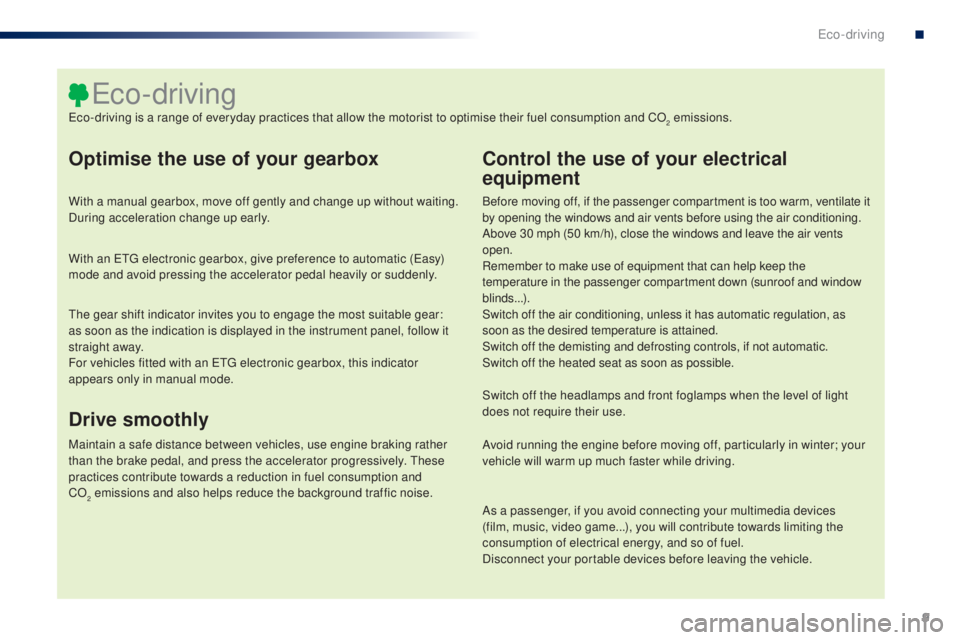
9
108_en_Chap00c_eco-conduite_ed01-2016
optimise the use of your gearbox
With a manual gearbox, move off gently and change up without waiting.
During acceleration change up early.
With an etg electronic gearbox, give preference to automatic (
ea
sy)
mode and avoid pressing the accelerator pedal heavily or suddenly.
Control the use of your electrical
equipment
Before moving off, if the passenger compartment is too warm, ventilate it
by opening the windows and air vents before using the air conditioning.
Above 30 mph (50 km/h), close the windows and leave the air vents
open.
Remember to make use of equipment that can help keep the
temperature in the passenger compartment down (sunroof and window
blinds...).
Switch off the air conditioning, unless it has automatic regulation, as
soon as the desired temperature is attained.
Switch off the demisting and defrosting controls, if not automatic.
Switch off the heated seat as soon as possible.
Switch off the headlamps and front foglamps when the level of light
does not require their use.
Avoid running the engine before moving off, particularly in winter; your
vehicle will warm up much faster while driving.
As a passenger, if you avoid connecting your multimedia devices
(film, music, video game...), you will contribute towards limiting the
consumption of electrical energy, and so of fuel.
Disconnect your portable devices before leaving the vehicle.
eco-driving
eco-driving is a range of everyday practices that allow the motorist to optimise their fuel consumption and CO2 emissions.
th
e gear shift indicator invites you to engage the most suitable gear:
as soon as the indication is displayed in the instrument panel, follow it
straight away.
For vehicles fitted with an
etg
electronic gearbox, this indicator
appears only in manual mode.
Drive smoothly
Maintain a safe distance between vehicles, use engine braking rather
than the brake pedal, and press the accelerator progressively. th ese
practices contribute towards a reduction in fuel consumption and
CO
2 emissions and also helps reduce the background traffic noise.
.
eco-driving
Page 12 of 268
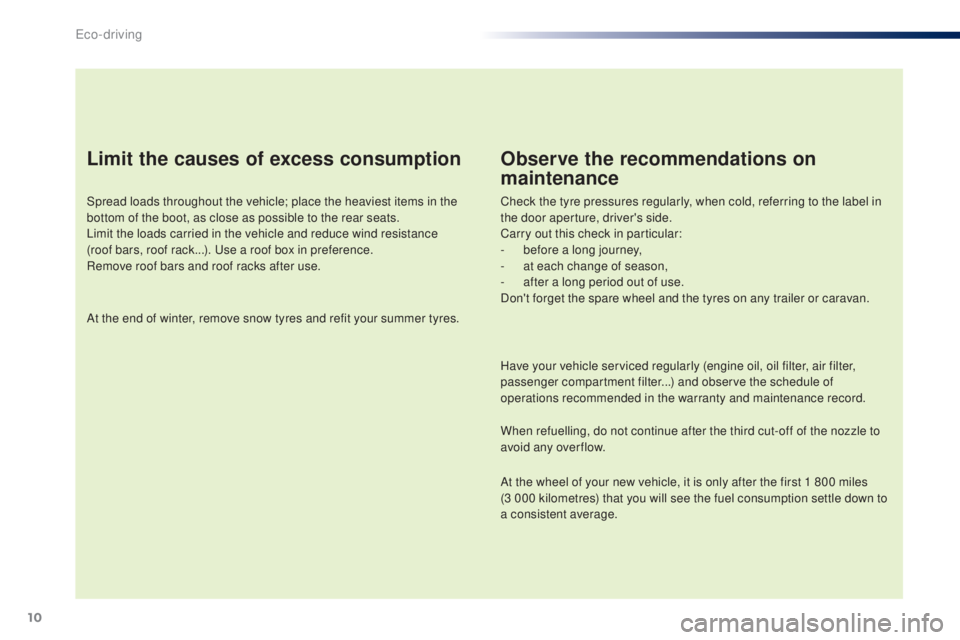
10
108_en_Chap00c_eco-conduite_ed01-2016
Limit the causes of excess consumption
Spread loads throughout the vehicle; place the heaviest items in the
bottom of the boot, as close as possible to the rear seats.
Limit the loads carried in the vehicle and reduce wind resistance
(roof bars, roof rack...). u
s
e a roof box in preference.
Remove roof bars and roof racks after use.
At the end of winter, remove snow tyres and refit your summer tyres.
observe the recommendations on
maintenance
Check the tyre pressures regularly, when cold, referring to the label in
the door aperture, driver's side.
Carry out this check in particular:
-
b
efore a long journey,
-
a
t each change of season,
-
a
fter a long period out of use.
Don't forget the spare wheel and the tyres on any trailer or caravan.
Have your vehicle serviced regularly (engine oil, oil filter, air filter,
passenger compartment filter...) and observe the schedule of
operations recommended in the warranty and maintenance record.
When refuelling, do not continue after the third cut-off of the nozzle to
avoid any over flow.
At the wheel of your new vehicle, it is only after the first 1 800 miles
(3
000 kilometres) that you will see the fuel consumption settle down to
a consistent average.
eco-driving
Page 13 of 268
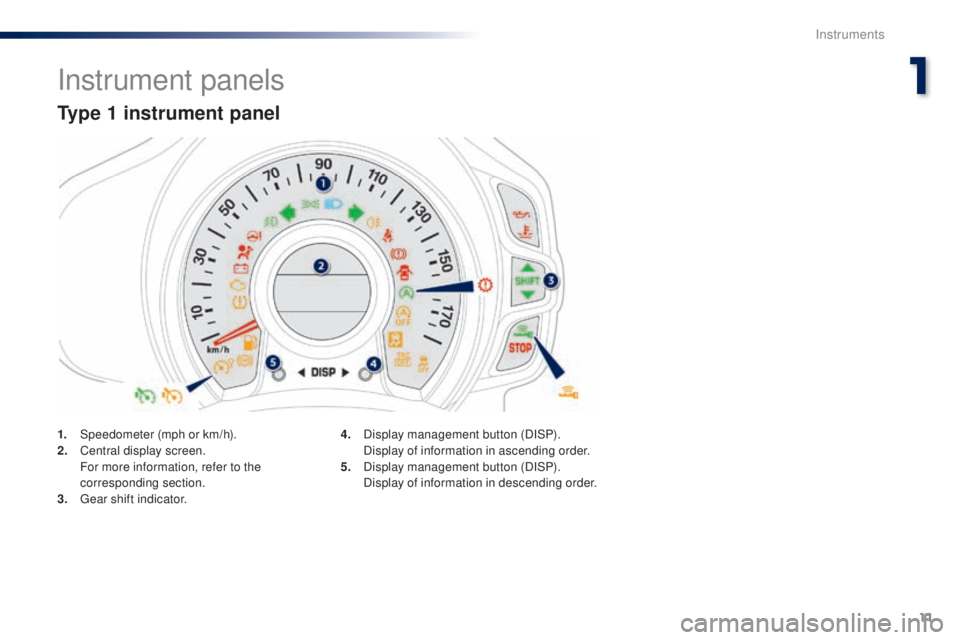
11
108 _en_Chap01_instrument- de-bord_ed01-2016
Instrument panels
type 1 instrument panel
1. Speedometer (mph or km/h).
2. Central display screen.
F
or more information, refer to the
corresponding section.
3.
g
e
ar shift indicator. 4. D
isplay management button (DISP). D
isplay of information in ascending order.
5.
D
isplay management button (DISP).
D
isplay of information in descending order.
1
Instruments
Page 14 of 268
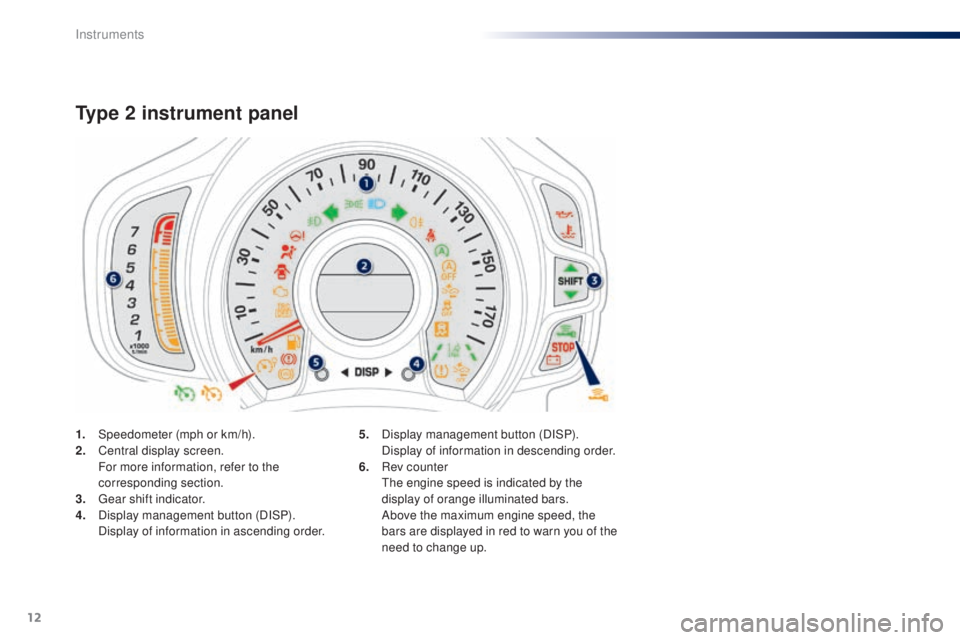
12
1. Speedometer (mph or km/h).
2. Central display screen.
F
or more information, refer to the
corresponding section.
3.
g
e
ar shift indicator.
4.
D
isplay management button (DISP).
D
isplay of information in ascending order.
type 2 instrument panel
5. Display management button (DISP). D isplay of information in descending order.
6.
R
ev counter
t
h
e engine speed is indicated by the
display of orange illuminated bars.
A
bove the maximum engine speed, the
bars are displayed in red to warn you of the
need to change up.
Instruments
Page 15 of 268
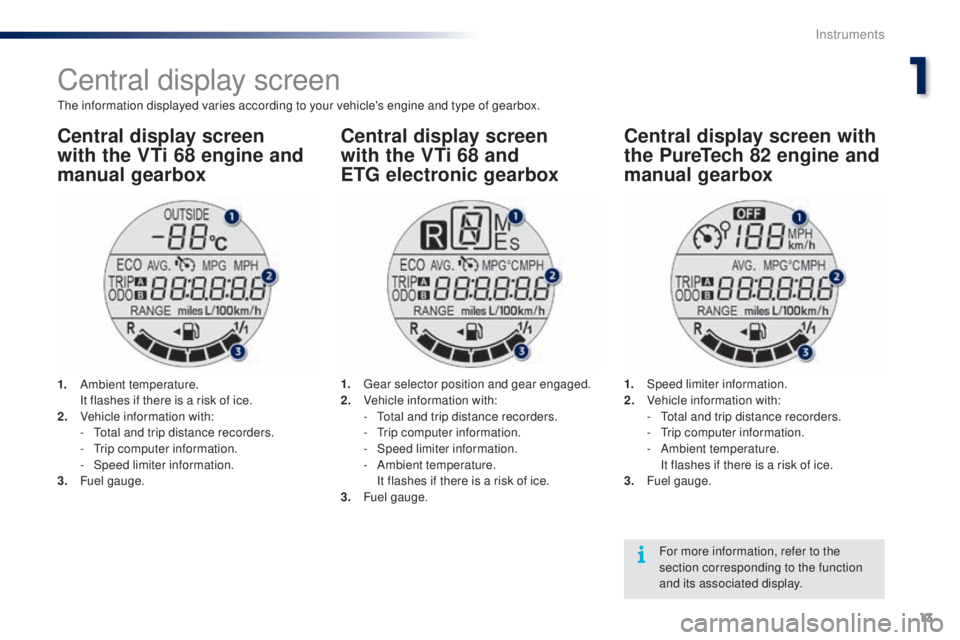
13
108 _en_Chap01_instrument- de-bord_ed01-2016
Central display screen
the information displayed varies according to your vehicle's engine and type of gearbox.
Central display screen
with the V
ti
68 engine and
manual gearbox Central display screen
with the V
ti
68 and
et
g electronic gearboxCentral display screen with
the Pure
te
ch 82 engine and
manual gearbox
1. Ambient temperature. I
t flashes if there is a risk of ice.
2.
V
ehicle information with:
-
t
o
tal and trip distance recorders.
-
t
r
ip computer information.
-
S
peed limiter information.
3.
F
uel gauge. 1.
gea r selector position and gear engaged.
2. V ehicle information with:
-
t
o
tal and trip distance recorders.
-
t
r
ip computer information.
-
S
peed limiter information.
-
A
mbient temperature.
I
t flashes if there is a risk of ice.
3.
F
uel gauge.1. S
peed limiter information.
2. V ehicle information with:
-
t
o
tal and trip distance recorders.
-
t
r
ip computer information.
-
A
mbient temperature.
I
t flashes if there is a risk of ice.
3.
F
uel gauge.For more information, refer to the
section corresponding to the function
and its associated display.
1
Instruments
Page 16 of 268
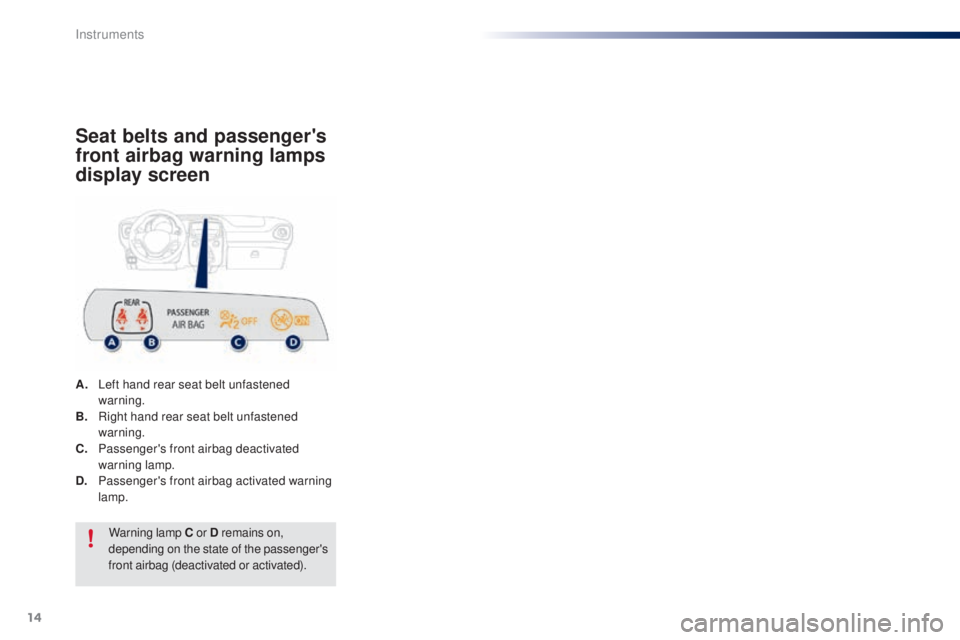
14
Seat belts and passenger's
front airbag warning lamps
display screen
A. Left hand rear seat belt unfastened warning.
B.
R
ight hand rear seat belt unfastened
warning.
C.
P
assenger's front airbag deactivated
warning lamp.
D.
P
assenger's front airbag activated warning
lamp.
Warning lamp C or D remains on,
depending on the state of the passenger's
front airbag (deactivated or activated).
Instruments
Page 17 of 268
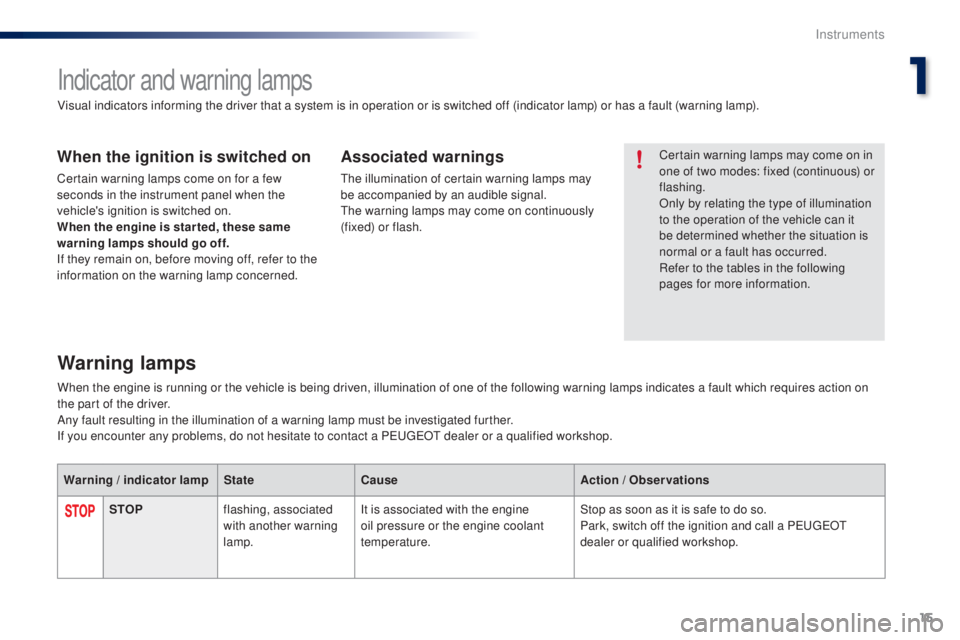
15
108 _en_Chap01_instrument- de-bord_ed01-2016
Indicator and warning lamps
Certain warning lamps may come on in
one of two modes: fixed (continuous) or
flashing.
Only by relating the type of illumination
to the operation of the vehicle can it
be determined whether the situation is
normal or a fault has occurred.
Refer to the tables in the following
pages for more information.
Visual indicators informing the driver that a system is in operation or is switched off (indicator lamp) or has a fault (warning lamp).When the ignition is switched on
Certain warning lamps come on for a few
seconds in the instrument panel when the
vehicle's ignition is switched on.
When the engine is star ted, these same
warning lamps should go off.
If they remain on, before moving off, refer to the
information on the warning lamp concerned.
Associated warnings
the illumination of certain warning lamps may
be accompanied by an audible signal.
th
e warning lamps may come on continuously
(fixed) or flash.
Warning lamps
StoP f lashing, associated
with another warning
lamp. It is associated with the engine
oil pressure or the engine coolant
temperature. Stop as soon as it is safe to do so.
Park, switch off the ignition and call a Pe
ugeOt
dealer or qualified workshop.
When the engine is running or the vehicle is being driven, illumination of one of the following warning lamps indicates a fault which requires action on
the part of the driver.
Any fault resulting in the illumination of a warning lamp must be investigated further.
If you encounter any problems, do not hesitate to contact a P
e
uge
Ot
dealer or a qualified workshop.
Warning / indicator lamp StateCause Action / o
b
servations
1
Instruments
Page 18 of 268
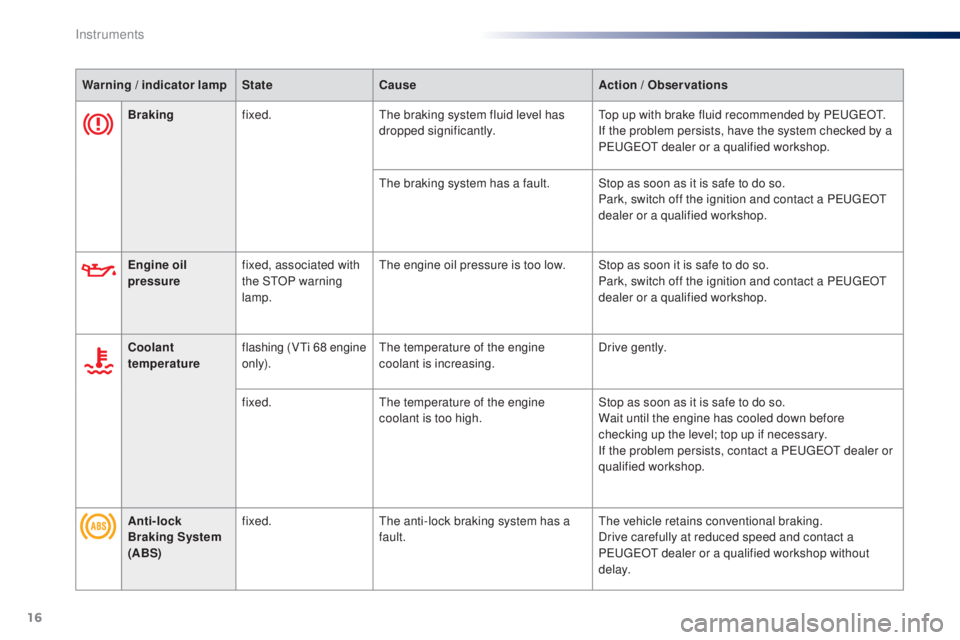
16
Brakingfixed.th e braking system fluid level has
dropped significantly.to p up with brake fluid recommended by Pe ugeOt.
I f the problem persists, have the system checked by a
P
e
uge
Ot
dealer or a qualified workshop.
th
e braking system has a fault. Stop as soon as it is safe to do so.Park, switch off the ignition and contact a P
e
uge
Ot
dealer or a qualified workshop.
Warning / indicator lamp
StateCause Action / o
b
servations
en
gine oil
pressure fixed, associated with
the S
tO
P warning
lamp.
th
e engine oil pressure is too low. Stop as soon it is safe to do so.Park, switch off the ignition and contact a P
e
uge
Ot
dealer or a qualified workshop.
Coolant
temperature flashing (V
ti 6
8
e
ngine
only).
the
temperature of the engine
coolant is increasing. Drive gently.
fixed.
the
temperature of the engine
coolant is too high. Stop as soon as it is safe to do so.
Wait until the engine has cooled down before
checking up the level; top up if necessary.
If the problem persists, contact a P
e
uge
Ot
dealer or
qualified workshop.
Anti-lock
Braking System
(ABS) fixed.
th
e anti-lock braking system has a
fault.
th
e vehicle retains conventional braking.
Drive carefully at reduced speed and contact a
P
e
uge
Ot
dealer or a qualified workshop without
d e l ay.
Instruments
Page 19 of 268
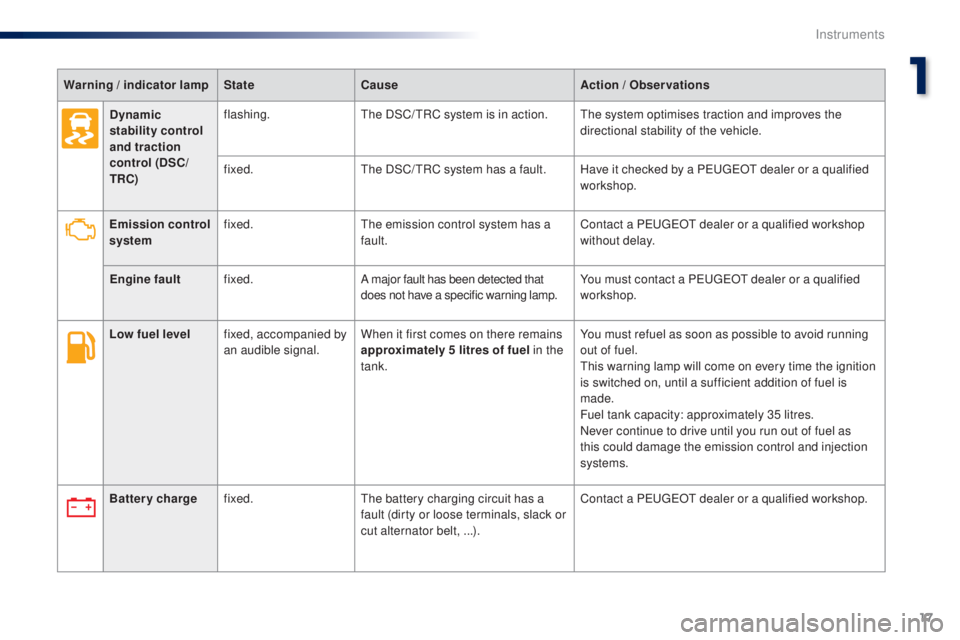
17
108 _en_Chap01_instrument- de-bord_ed01-2016
Low fuel levelfixed, accompanied by
an audible signal. When it first comes on there remains
approximately 5 litres of fuel
in the
tank. You must refuel as soon as possible to avoid running
out of fuel.
th
is warning lamp will come on every time the ignition
is switched on, until a sufficient addition of fuel is
made.
Fuel tank capacity: approximately 35 litres.
Never continue to drive until you run out of fuel as
this could damage the emission control and injection
systems.
Battery charge fixed.
th
e battery charging circuit has a
fault (dirty or loose terminals, slack or
cut alternator belt, ...). Contact a P
e
uge
Ot
dealer or a qualified workshop.
em
ission control
system fixed.
th
e emission control system has a
fault. Contact a P
e
uge
Ot
dealer or a qualified workshop
without delay.
en
gine fault
fixed. A major fault has been detected that
does not have a specific warning lamp. You must contact a P
e
uge
Ot
dealer or a qualified
workshop.
Dynamic
stability control
and traction
control (DSC/
tR
C)
flashing.
th
e DSC/
tR
C system is in action.
th
e system optimises traction and improves the
directional stability of the vehicle.
fixed.
th
e DSC/
tR
C system has a fault. Have it checked by a P
e
uge
Ot
dealer or a qualified
workshop.
Warning / indicator lamp
StateCause Action / o
b
servations
1
Instruments
Page 20 of 268
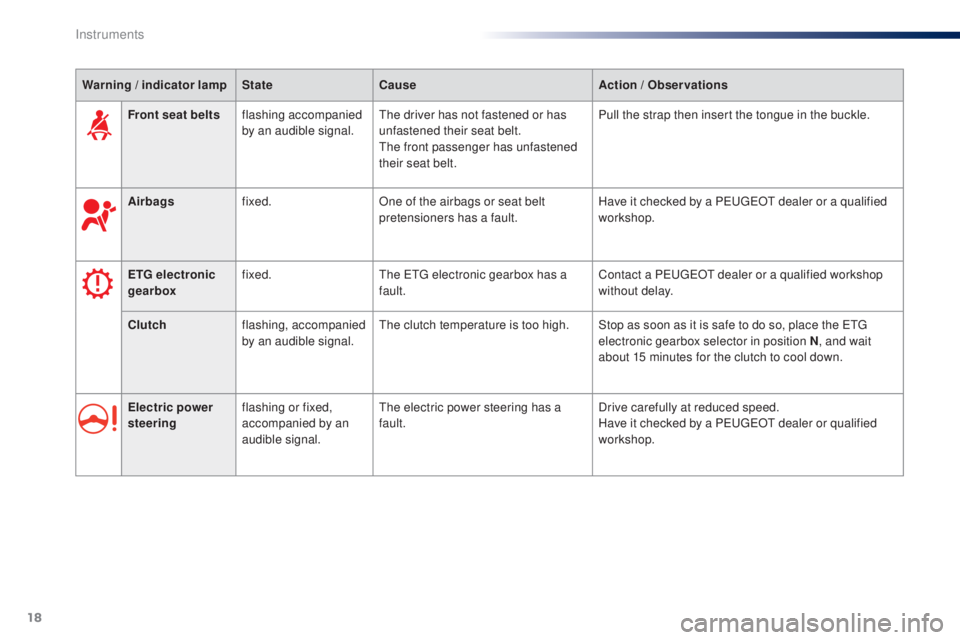
18
Front seat beltsflashing accompanied
by an audible signal.th e driver has not fastened or has
unfastened their seat belt.
the
front passenger has unfastened
their seat belt. Pull the strap then insert the tongue in the buckle.
Warning / indicator lamp
StateCause Action / o
b
servations
el
ectric power
steering flashing or fixed,
accompanied by an
audible signal.
th
e electric power steering has a
fault. Drive carefully at reduced speed.
Have it checked by a P
e
uge
Ot
dealer or qualified
workshop.
Airbags
fixed. One of the airbags or seat belt
pretensioners has a fault. Have it checked by a P
e
uge
Ot
dealer or a qualified
workshop.
e
tg electronic
gearbox fixed.
th
e etg electronic gearbox has a
fault. Contact a P
e
uge
Ot
dealer or a qualified workshop
without delay.
Clutch flashing, accompanied
by an audible signal.
th
e clutch temperature is too high. Stop as soon as it is safe to do so, place the etg
electronic gearbox selector in position N , and wait
about 15 minutes for the clutch to cool down.
Instruments